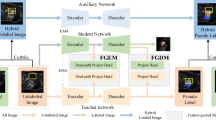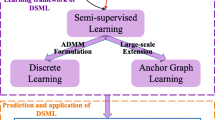Abstract
In medical image analysis, obtaining high-quality labeled data is expensive, and there is a large amount of unlabeled image data that is not utilized. Semi-supervised learning can use unlabeled data to improve the model performance in the presence of data scarcity medical image analysis. In this paper, we propose a semi-supervised framework for medical image classification considering both feature extraction layer information and semantic classification layer information. It is a method that includes a combined pseudo-labeling strategy and a feature distance metric consistency method. Compared with other semi-supervised classification methods, our method significantly improves the accuracy of pseudo-labels by combining the feature metric pseudo-label with the semantic classification pseudo-label and enables the model to explore deeper information by constraining the distance relations of sample features in the feature space. We conducted extensive experiments on two public medical image datasets to demonstrate that our method outperforms various state-of-the-art semi-supervised learning methods.




Similar content being viewed by others
Data Availibility
The datasets generated during and/or analysed during the current study are available from the corresponding author on reasonable request.
References
Battaglia P, Hamrick J, Bapst V, Sanchez-Gonzalez A, Zambaldi V, Malinowski M, Tacchetti A, Raposo D, Santoro A, Faulkner R, Pascanu R (2018) Relational inductive biases, deep learning, and graph networks. arXiv preprint arXiv:1806.01261
Berthelot D, Carlini N, Cubuk E, Kurakin A, Sohn K, Zhang H, Raffel C (2019) Remixmatch: Semi-supervised learning with distribution alignment and augmentation anchoring. arXiv:1911.09785
Berthelot D, Carlini N, Goodfellow I, Papernot N, Oliver A, Raffel C (2019) Mixmatch: A holistic approach to semi-supervised learning. Adv in Neural inf Process syst 32
Chapelle O, Chi M, Zien A (2006) A continuation method for semi-supervised SVMs. In Proceedings of the 23rd international conference on Machine learning pp. 185-192
Cohen J, Morrison P, Dao L (2020) COVID-19 image data collection. arXiv:2003.11597
Girshick R (2015). Fast r-cnn. In Proceedings of the IEEE international conference on computer vision pp. 1440–1448
Grandvalet Y, Bengio Y (2004) Semi-supervised learning by entropy minimization. Advances in neural information processing systems, 17
Hadsell R, Chopra S, LeCun Y (2006) Dimensionality reduction by learning an invariant mapping. In 2006 IEEE Computer Society Conference on Computer Vision and Pattern Recognition (CVPR’06) Vol. 2, pp. 1735–1742. IEEE
Huang G, Liu Z, Van Der Maaten L, Weinberger K (2017) Densely connected convolutional networks. In Proceedings of the IEEE conference on computer vision and pattern recognition pp. 4700–4708
Iscen A, Tolias G, Avrithis Y, Chum O (2019) Label propagation for deep semi-supervised learning. In Proceedings of the IEEE/CVF Conference on Computer Vision and Pattern Recognition pp. 5070–5079
Kim E, Kim S, Seo M, Yoon S (2021) XProtoNet: diagnosis in chest radiography with global and local explanations. In Proceedings of the IEEE/CVF conference on computer vision and pattern recognition (pp. 15719-15728)
Krizhevsky A, Sutskever I, Hinton G (2017) Imagenet classification with deep convolutional neural networks. Communications of the ACM 60(6):84–90
Laine S, Aila T (2016) Temporal ensembling for semi-supervised learning. arXiv:1610.02242
Lecouat B, Chang K, Foo C, Unnikrishnan B, Brown J, Zenati H,Beers A, Chandrasekhar V, Kalpathy-Cramer J, Krishnaswamy P (2018) Semi-supervised deep learning for abnormality classification in retinal images. arXiv:1812.07832
Lee D (2013) Pseudo-label: The simple and efficient semi-supervised learning method for deep neural networks. In Workshop on challenges in representation learning, ICML 3(2):896
Liu Q, Yu L, Luo L, Dou Q, Heng P (2020) Semi-supervised medical image classification with relation-driven self-ensembling model. IEEE Transactions on Medical Imaging 39(11):3429–3440
Liu Y, Cao J, Li B, Yuan C, Hu W, Li Y, Duan Y (2019) Knowledge distillation via instance relationship graph. In Proceedings of the IEEE/CVF Conference on Computer Vision and Pattern Recognition pp. 7096—7104
Liu F, Tian Yu, Chen Y, Liu Y, Belagiannis V, Carneiro G (2022) ACPL: Anti-Curriculum Pseudo-Labelling for Semi-Supervised Medical Image Classification. In Proceedings of the IEEE/CVF Conference on Computer Vision and Pattern Recognition pp. 20697–20706
Lu H, An C, Zheng E, Lu Y (2014) Dissimilarity based ensemble of extreme learning machine for gene expression data classification. Neurocomputing 128:22–30
Lu H, Chen J, Yan K, Jin Q, Xue Y, Gao Z (2017) A hybrid feature selection algorithm for gene expression data classification. Neurocomputing 256:56–62
Lu H, Yang L, Yan K, Xue Y, Gao Z (2017) A cost-sensitive rotation forest algorithm for gene expression data classification. Neurocomputing 228:270–276
Madani A, Ong J, Tibrewal A, Mofrad M (2018) Deep echocardiography: data-efficient supervised and semi-supervised deep learning towards automated diagnosis of cardiac disease. NPJ digital medicine 1(1):1–11
Madani A, Moradi M, Karargyris A, Syeda-Mahmood T (2018) Semi-supervised learning with generative adversarial networks for chest X-ray classification with ability of data domain adaptation. In 2018 IEEE 15th International symposium on biomedical imaging (ISBI 2018) pp. 1038–1042. IEEE
Mangal A, Kalia S, Rajgopal H, Rangarajan K, Namboodiri V, Banerjee S, Arora C (2020) CovidAID: COVID-19 detection using chest X-ray. arXiv:2004.09803
Miyato T, Maeda S, Koyama M, Ishii S (2018) Virtual adversarial training: a regularization method for supervised and semi-supervised learning. IEEE transactions on pattern analysis and machine intelligence 41(8):1979–1993
Mooney P (2018) Kaggle chest x-ray images (pneumonia) dataset. https://www.kaggle.com/paultimothymooney/chest-xray-pneumonia
Prakash V, Nithya D (2014) A survey on semi-supervised learning techniques. arXiv:1402.4645
Rajpurkar P, Irvin J, Zhu K, Yang B, Mehta H, Duan T, Ding D, Bagul A, Langlotz C, Shpanskaya K (2017). Chexnet: Radiologist-level pneumonia detection on chest x-rays with deep learning. arXiv:1711.05225
Russakovsky O, Deng J, Su H, Krause J, Satheesh S, Ma S, Huang Z, Karpathy A, Khosla A, Bernstein M, Berg A, Fei-Fei L (2015) Imagenet large scale visual recognition challenge. International journal of computer vision 115(3):211–252
Sajjadi M, Javanmardi M, Tasdizen T (2016) Regularization with stochastic transformations and perturbations for deep semi-supervised learning. Adv Neural Inf Process Syst 29
Sohn K, Berthelot D, Carlini N, Zhang Z, Zhang H, Raffel C, Cubuk E, Kurakin A, Li C (2020) Fixmatch: Simplifying semi-supervised learning with consistency and confidence. Advances in neural information processing systems 33:596–608
Taherkhani F, Dabouei A, Soleymani S, Dawson J, Nasrabadi N (2021) Self-supervised wasserstein pseudo-labeling for semi-supervised image classification. In Proceedings of the IEEE/CVF Conference on Computer Vision and Pattern Recognition pp. 12267-12277
Tarvainen A, Valpola H (2017) Mean teachers are better role models: Weight-averaged consistency targets improve semi-supervised deep learning results. Adv Neural inf Process syst 30
Tschandl P, Rosendahl C, Kittler H (2018) The HAM10000 dataset, a large collection of multi-source dermatoscopic images of common pigmented skin lesions. Scientific data 5(1):1–9
Van Engelen J, Hoos H (2020) A survey on semi-supervised learning. Machine Learning 109(2):373–440
Wang D, Zhang Y, Zhang K, Wang L (2020) Focalmix: Semi-supervised learning for 3d medical image detection. In Proceedings of the IEEE/CVF Conference on Computer Vision and Pattern Recognition pp. 3951–3960
Yi X, Walia E, Babyn P (2018) Unsupervised and semi-supervised learning with categorical generative adversarial networks assisted by wasserstein distance for dermoscopy image classification. arXiv:1804.03700
Zhang B, Wang Y, Hou W, Wu H, Wang J, Okumura M, Shinozaki T (2021) Flexmatch: Boosting semi-supervised learning with curriculum pseudo labeling. Adv Neural Inf Process Syst 34:18408–18419
Zhang W, Zhu L, Hallinan J, Zhang S, Makmur A, Cai Q, Ooi B (2022) Boostmis: Boosting medical image semi-supervised learning with adaptive pseudo labeling and informative active annotation. In Proceedings of the IEEE/CVF Conference on Computer Vision and Pattern Recognition pp. 20666–20676
Zheng M, You S, Huang L, Wang F, Qian C, Xu C (2022) SimMatch: Semi-supervised Learning with Similarity Matching. In Proceedings of the IEEE/CVF Conference on Computer Vision and Pattern Recognition pp. 14471–14481
Zhou Y, He X, Huang L, Liu L, Zhu F, Cui S, Shao L (2019) Collaborative learning of semi-supervised segmentation and classification for medical images. In Proceedings of the IEEE/CVF conference on computer vision and pattern recognition pp. 2079-2088
Zhou H, Wang C, Li H, Wang G, Zhang S, Li W, Yu Y (2021) SSMD: semi-supervised medical image detection with adaptive consistency and heterogeneous perturbation. Med Image Anal 72 102117
Acknowledgements
In this paper, the research is sponsored by the National Natural Science Foundation of China (61272315), the Natural Science Foundation of Zhejiang Province (LQ20F030015, LY21F020028, 2023C01040), and the Foundation of Zhejiang Educational Committee (Y202147815).
Author information
Authors and Affiliations
Corresponding authors
Ethics declarations
Conflicts of interest
The authors declare that they have no conflict of interests.
Additional information
Publisher's Note
Springer Nature remains neutral with regard to jurisdictional claims in published maps and institutional affiliations.
Rights and permissions
Springer Nature or its licensor (e.g. a society or other partner) holds exclusive rights to this article under a publishing agreement with the author(s) or other rightsholder(s); author self-archiving of the accepted manuscript version of this article is solely governed by the terms of such publishing agreement and applicable law.
About this article
Cite this article
Ke, B., Lu, H., You, C. et al. A semi-supervised medical image classification method based on combined pseudo-labeling and distance metric consistency. Multimed Tools Appl 83, 33313–33331 (2024). https://doi.org/10.1007/s11042-023-16383-w
Received:
Revised:
Accepted:
Published:
Issue Date:
DOI: https://doi.org/10.1007/s11042-023-16383-w




